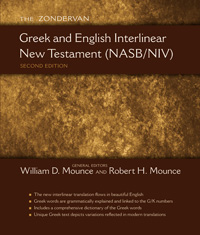
Vowel pointing in particular is difficult to see even with the magnifying glass. I have to use a magnifying glass with this book. The print in Green’s Interlinear Bible (Green) is very small and, at least in my copy and in other copies I have seen, somewhat poor quality. The order of the books of the Hebrew Bible (Old Testament) is the same as found in most Christian Bibles, as is the verse numbering.īesides the Masoretic Text in Hebrew and the English translation, this interlinear Bible displays numbers over the Hebrew (and Greek) keyed to Strong’s Concordance. It is called A Literal Translation of the Bible (often abbreviated LITV) and is also available by itself. In a column to the side of the interlinear text is an English text, reading nearly identical to that below the Hebrew except for some word order formatting. The English below the Hebrew and Greek is a literal translation by Jay P. The Greek New Testament says it is the Textus Receptus, or Received Text, with some “departures.” This is a Byzantine family text, the source text for the King James Version as opposed to most modern English translations. This interlinear Bible says the Hebrew Old Testament is the Masoretic Text, a broad classification of several similar Hebrew texts. I personally have the single volume second edition, ©1986 from Sovereign Grace Publishers, and it is possible some of my observations would be different in another printing. It comes in both a single volume (Old and New Testaments) or a 4-volume set (Old Testament in 3 volumes and New Testament). Green’s Interlinear Bible is probably the most well-known interlinear Bible for Christian users. Green, Sr., General Editor and Translator (1918-2008) This is one reason why no readable English Bible translation is perfectly literal.Ĭlick to enlarge The Interlinear Bible Hebrew-Greek-English Remember also that the English text is a literal translation of Hebrew, in the same order as the Hebrew words, and therefore is very awkward. The English words or groups of words are read in order from right to left. In this example (from the Hebrew-English Interlinear ESV Old Testament) the multiple English words required to translate one Hebrew word are connected by dashes. Here is an example illustrating how the English looks below the Hebrew text. In addition to the directional issue, often it takes several English words to translate one Hebrew word. Because the primary text (Hebrew, a Semitic language) is written right-to-left, and English is written left-to-right, it can be tricky to follow the English text.

There is one particular issue to note with Hebrew-English interlinear text. Schottenstein Interlinear Chumash by Rabbi Menachem Davis The Apostolic Bible Polyglot by Charles Vanderpool Interlinear Greek-English New Testament by George Ricker Berry Greek-English Interlinear ESV New Testament Hebrew-English Interlinear ESV Old Testament The Interlinear Bible: Hebrew-Greek-English by Jay P. Here are a few popular Interlinear Bibles to consider: The Hebrew text and English text are not on alternating lines. These are parallel bilingual editions, but they are not interlinear. The Israel Bible, the JPS Hebrew-English Tanakh, Aramaic-English New Testament, and the Stone Edition Chumash or Tanach are a few examples. Many of us have Bibles with both Hebrew and English, either on facing pages or in parallel columns. Likewise a Greek-English Interlinear New Testament will have Greek text with the corresponding English words below it. Specifically, a Hebrew-English Interlinear Bible has both the Hebrew and English text of the Hebrew Bible on alternating lines of the same page, generally with the corresponding English words written directly below the Hebrew texts. An “interlinear gloss” is a book having the same text in different languages printed on alternate lines, and an Interlinear Bible is an interlinear gloss of the Scripture text.

“Interlinear” means that something is written or printed between the lines of text. Using them can be helpful to our understanding, but misusing them can be precarious.Īnother useful tool for studying Scripture based on the original languages is an Interlinear Bible.

Theological Wordbook of the Old Testament
Nasb hebrew greek interlinear bible driver#
Strong’s Exhaustive Concordance of the Bibleīrown Driver Briggs Hebrew and English Lexicon Often our ties to the original languages of the Bible are references written primarily in English. Unless we are fluent in another language, English is the only real option. Those of us in the English speaking world read our Bibles as translated for us from the original ancient languages.


 0 kommentar(er)
0 kommentar(er)
